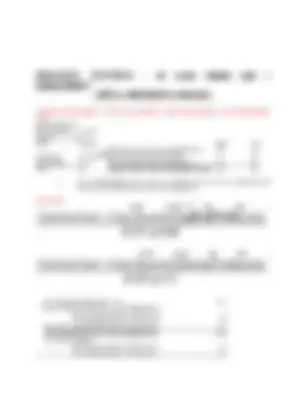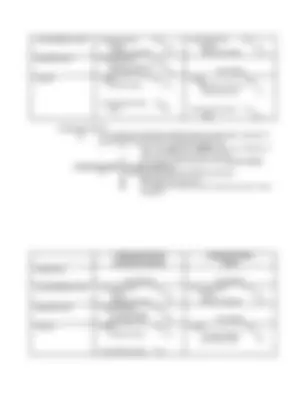















































Study with the several resources on Docsity

Earn points by helping other students or get them with a premium plan


Prepare for your exams
Study with the several resources on Docsity

Earn points to download
Earn points by helping other students or get them with a premium plan
Community
Ask the community for help and clear up your study doubts
Discover the best universities in your country according to Docsity users
Free resources
Download our free guides on studying techniques, anxiety management strategies, and thesis advice from Docsity tutors
A detailed calculation of gross profit/(loss) for a construction project, including revenue, cost of sales, and cost of inventory transferred out. It also covers the calculation of consolidated net income and the allocation of normal and abnormal lost units using both fifo and weighted average methods.
Typology: Study notes
1 / 53

This page cannot be seen from the preview
Don't miss anything!














































RETAIL COST Allowance SFHO P xx Net of Markup Retail - Cost Outside Purchase xx Just copy amount n/a COGAS P xx P xx P xx End. Inventory SHFO ( xx ) Net of Markup Retail - Cost Outside Purchase ( xx ) Just copy amount n/a COGS P xx P xx P xx.
If Based on Sales: Cost = SFHO - (SFHO x Markup Rate)
Home Office Branch Sales P xx Sales P xx COGS ( xx ) COGS ( xx ) Gross Profit P xx Gross Profit P xx OpEx ( xx ) OpEx ( xx ) Net Income P xx Unrecorded Expenses ( xx ) Net Income P xx Realized portion of Allowance xx True Income P xx It is the NET INCOME that is reflected in the FS of the brand and HO, and not the true income.
Beginning Inventory P xx Purchases xx Less: Shipment to Branch ( xx ) Ending Inventory ( xx ) COGS P xx
% of COMPLETION ZERO PROFIT Contract Price P xx P xx Less: TEC Cumulative Cost Incurred to Date P xx P xx Est. Cost to Complete xx xx TEC P xx xx P xx xx Est. Gross Profit/(Loss) P xx P xx/(xx) Multiply by: % of Completion x% Gross Profit/(loss) to Date P xx P(xx) Less: PY Gross P/L to Date xx xx Realized Gross P/L for the Year P xx P xx COMPUTATION OF % OF COMPLETION: % of Completion =
“Est. Cost AT completion” = TEC Alternative Formula: % of Completion =
applies only if there’s NO LOSS OTHER FORMULAS: Contract Price P xx Multiply by: % of Completion x% REVENUE TO DATE P xx Less: Cost incurred to Date ( xx ) Gross Profit/(Loss) to Date P xx Revenue to Date (Current Year) P xx Revenue to Date (Prior Year) ( xx ) Revenue for the year P xx Construction cost of Sales (Squeezed) ( xx ) Gross Profit/(Loss) for the Year P xx CONSTRUCTION IN PROGRESS CONSTRUCTION IN PROGRESS Cost incurred to date P xx Gross Profit for the year xx (^) P xx Loss for the Year CIP, Balance P xx CIP > Progress Billing = ASSET CIP < Progress Billing = LIABILITY
CFF P xx Interest Income xx Indirect Cost ( xx ) NET INCOME P xx CONSIGNMENT Net Sales P xx Cost of Sales ( xx ) Gross Profit P xx OpEx ( xx ) Commission Expense ( xx ) Freight-out ( xx ) Bad debt Expense ( xx ) Samples Consumed ( xx ) NET INCOME P xx Cash/Collection from credit sales P xx Less: Payment made by consignee in behalf of the consignor ( xx ) Sales Commission ( xx ) NET REMITTANCE P xx Cost of Consigned goods * (units sold/total units) P xx Freight In * (units sold/total units) xx Cartage Cost * (units sold/total units) xx COST OF SALES P xx PART OF COST OF SALES
GOVERNMENT ACCOUNTING JOURNAL ENTRIES:
Loan payable - Foreign Currency P xx
Regular Agency Fund, Foreign Assisted Project Fund, and Trust receipts are different fund cluster.
If the FV of the previously acquired shares (without controlling interest) is not given at the time there’s new acquisition that makes it to have controlling interest, use this formula: FV of Previously =
x % of Previously Acquired Shares Acquired Shares FULL GOODWILL METHOD IS USE Always compare the FV of the NCI to the proportionate share of the NCI. If Proportionate share is greater than the FV, then use the proportionate share of NCI. FV OF NCI =
x % of NCI Total Assets (Not including unidentifiable assets) P xx Less: Total Liabilities ( xx ) FAIR VALUE OF NET ASSETS P xx Less: Overvaluation of Assets ( xx ) Add: Undervaluation of Assets xx ADJUSTED FVNA P xx Multiply by: % of NCI x% Proportionate Share of NCI P xx FVNA P xx Less: Consideration % controlling Interest ( xx ) % of NCI ( xx ) BARGAIN/(GOODWILL) P xx For the consolidated TOTAL ASSETS; Parent - BOOK VALUE ; SUBSIDIARY - FV Don’t include unidentifiable intangible assets of SUBSIDIARY
WORKING PAPERS ON THE DATE OF ACQUISITION
Depreciation Expense - Parent P xx Depreciation Expense - Subsidiary xx Amortized portion of Under/(Over) Valued FA xx/(xx) Amortized portion of (URP)/URL of FA (xx)/xx CONSOLIDATED DEPRECIATION EXPENSE P xx UNREALIZED PROFIT/(LOSS ) =
x % of Unrealized Portion REALIZED PROFIT/(LOSS) =
x % of Realized Portion CONSOLIDATED NET INCOME PARENT - CI SUBSIDIARY - NCI Net Income - Parent P xx Net Income - Subsidiary xx P xx Realized URP/(URL) from PY - if Down xx/(xx) Realized URP/(URL) from PY - if UpS xx/(xx) xx/(xx) (URP)/URL - if DownS (xx)/xx (URP)/URL - if UpS (xx)/xx (xx)/xx Amortization Excess xx/(xx) xx/(xx) Intercompany Dividends (xx) Gain on Acquisition xx P xx P xx CONSOLIDATED FIXED ASSETS Fixed Assets - Parent P xx Fixed Assets - Subsidiary xx (Over)/Under Valuation of FA (xx)/xx Amortized portion of Over/(Under) valued FA xx/(xx) URP/(URL) on sale of FA xx/(xx) (RP)/RL on sale of FA (xx)/xx CONSOLIDATED FIXED ASSETS P xx If the fixed asset is a LAND, no amortization needed, recognized the whole amount.
PARENT/SUBSIDIARY: Accounts Receivable P xx Sales P xx PARENT/SUBSIDIARY: Merchandise Inventory P xx Accounts Payable P xx WORKING PAPER ENTRIES:
BUSINESS COMBINATION - MERGER TOTAL ASSETS OF MERGED CORPORATION Book Value of the Assets of ACQUIRER P xx FV of the Assets of ACQUIREE xx Cash Consideration Paid ( xx ) Acquisition Related Cost Paid ( xx ) Goodwill from Acquisition ( xx ) TOTAL ASSETS OF THE MERGED CORPORATION P xx TOTAL LIABILITIES OF MERGED CORPORATION BV of the Liabilities of ACQUIRER P xx FV of the Liabilities of ACQUIREE xx Bonds issued by the ACQUIRER xx Premium/(Discount) of Bonds Issued xx/(xx) Bond Issue Cost ( xx ) Contingent Liability (at FV) xx TOTAL LIABILITIES OF THE MERGED CORPORATION P xx SHARE PREMIUM OF MERGED CORPORATION Share Premium - ACQUIRER P xx Share Premium - Contingent Consideration xx Share Premium from the issuance (consideration) xx Share Issuance Cost ( xx ) TOTAL SHARE PREMIUM OF THE MERGED CORPORATION P xx SHARE CAPITAL OF MERGED CORPORATION Share Capital - ACQUIRER P xx Share Capital from Issuance (consideration) xx Share Capital -Contingent Consideration xx TOTAL SHARE CAPITAL OF THE MERGED CORPORATION P xx RETAINED EARNINGS OF THE MERGED CORPORATION Retained Earnings - ACQUIRER P xx Acquisition Related Expense ( xx ) Gain from Acquisition xx Excess of Share Issue Cost from Share Issuance ( xx ) TOTAL RETAINED EARNINGS OF THE MERGED CORPORATION P xx
FREE ASSETS UNSECURED PORTION OF LIABILITIES LIABILITIES ALREADY SECURED CASH Receivable (assuming pledged to FSL) Inventory (assuming pledged to PSL) Unsecured Liabilities w/o Priority P xx If there’s excess (FV of ASSETS - FSL) Leave it blank if NO excess P xx xx P xx P xx FREE ASSETS Less: Unsecured Liabilities w/ Priority Liquidating Exp. Salaries Payable Taxes P xx ( xx ) ( xx ) ( xx ) NET FREE ASSETS; Unsecured Liabilities P xx P xx
Free Assets P xx Less: Unsecured Liabilities with Priority ( xx ) Net Free Assets P xx Less: Total unsecured Liabilities without Priority ( xx ) Estimated Deficiency P xx ESTIMATED PAYMENT TO PARTIALLY SECURED CREDITOR = Amount Secured + (Unsecured Portion * % of Recovery) ESTIMATED PAYMENT TO UNSECURED CREDITORS w/O PRIORITY = Total Unsecured Liabilities w/o Priority * % of Recovery In COMPUTATING THE ESTIMATED LOSS ON ASSET REALIZATION, ADD all the lost and NEVER deduct the realized gain against the realized loss.
STATEMENT OF REALIZATION AND LIQUIDATION It shows how the receiver or trustee managed the assets of the debtor corporation on behalf of the creditors. ASSETS TO BE REALIZED Non-cash assets to be collected or sold for the given period. BV of all recorded non-cash assets INCREASE IN ASSETS Unrecorded non-cash assets Example: Accrued Interest Receivable
Non-cash assets collected or sold for the given period ASSETS NOT REALIZED Non-cash assets not collected or sold for the given period LIABILITIES LIQUIDATED Liabilities paid during the given period LIABILITIES NOT LIQUIDATED Liabilities not paid at the end of the period Liability to be Liquidated + Increase in Liability - Liabilities Liquidated = Liabilities not liquidated
Book value of the recorded liabilities to be paid in the given period INCREASE IN LIABILITIES Unrecorded Liabilities Liabilities Assumed Example: Accrued Interest Payable SUPPLEMENTARY DEBITS/CHARGES Expenses and Losses
Income, profits, sales and gains If the DEBIT side is GREATER than credit side, there’s a LOSS. Under perpetual Inventory system, any inventory sold is DEBITED to the GOGS (Dr. COGS; Cr. INVENTORIES) Realized asset are recorded at Realizable amount Asset to be realized does NOT include cash. So any cash earned and paid is NOT recorded in the above table. Assets to be Realized and Liabilities to be Liquidates serve as BEGINNING balances; whereas Asset not Realized and Liabilities not liquidated serve as ENDING balances. Liabilities to be Liquidated P xx
TAC = NP contribution / New Partner % Old Partner New Capital Balance = (Capital of OP –/+ Share in Difference between TCC & TAC) x (100% - NP%) Agreed Capital of New Partner = TAC x New Partner % Share of OP from Bonus = (CC of NP – AC of NP) x OP% PARTNERSHIP DISSOLUTION ADMISSION PURCHASE OF INTEREST If the problem is SILENT There’s only a simple transfer of capital Thus, TCC = TAC TCC TAC A P xx P xx B xx xx C xx P xx = P xx REVALUATION is assumed The amount paid by the new partner is the amount to be credited to his account TCC ≠ TAC TCC TAC A P xx P xx B xx xx C xx P xx ≠ P xx WAYS TO COMPUTE FOR NEW PROFIT and LOSS RATIO OP new Capital Ratio = % of OP x (100% - New Partner %) INVESTMENT The problem is SILENT The amount invested by the new partner in added to TCC Thus, TCC = TAC From TAC compute the equivalent capital of the new partner BONUS METHOD TCC TAC A P xx P xx B xx xx C xx xx P xx = P xx Agreed Capital of New Partner = TAC x New Partner % Capital Balance of Old Partners = Capital - % transferred to NP
whichever of the two produces Goodwill
Compute for the Agreed Capital that will result to Goodwill TAC = investment of NP / NP% ; or TAC = Capital of OP / (100% - NP%) Negative Goodwill is NOT applicable REVALUATION is assumed The amount invested by the NP is the amount to be credited in his capital The amount invested is also added to the TCC TCC ≠ TAC Difference between TCC and TAC is then distributed to OP TCC TAC A P xx P xx B xx xx C xx xx P xx ≠ P xx